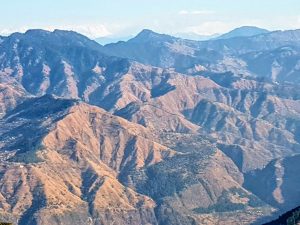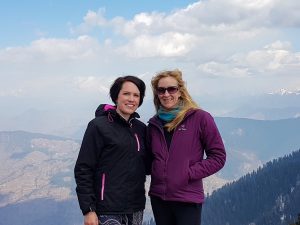At the car park of Hatu Peak we were greeted by a tall slim man wearing a suit who, politely and in English, introduced himself and his wife. The four of us all shook hands courteously as if we were meeting for a house viewing or business meeting. We didn’t know who he was was, why he wanted to talk to us or what he wanted, but felt the weight of expectation upon us. What were we supposed to say? Karen commented on his wife’s earrings which the man proceeded to try and take from her ears to give to us (no, no, no really – we didn’t actually want them, just trying to make conversation). I tried not laugh but the formality of the situation was really, really funny.

Hatu Peak is 3400 metres, the second highest peak in Himachal Pradesh. Coming here felt different to any other part of my travels. The territory felt exclusively Indian; there were no western tourists, and the white was of snow, not marble. We stopped in Narkanda, a muddy town centre edged with market stalls where the women eyed us with both suspicious and welcome. We bought some samosas and apples and continued on to the base of the peak.
Our hike up was through a forest of pine trees, over patches of snow and ice with views spreading far down and wide across the valley. At the top were some empty, abandoned buildings and a half completed temple which gave the area a somewhat sad, eerie atmosphere – a graveyard of lost dreams. Half-built buildings seemed to common place in India. Aside from three young men, we were the only ones at the peak. It felt strangely desolate, and very cold.

We sat down to eat our lunch just as the sun decided to show it’s face. The air was beautifully fresh and we could see for miles over the Sivalik Hills of the outer Himalayas – earthy triangular mountain tops which turned into snowy peaks, towards the Himalayas and into Tibet.
On the way down the mountain we met a groups of friends who wanted to film themselves doing press-ups in the snow. Coming from the steamy climes of Kerala, they had never seen the white stuff before and were keen for Karen and I to join their celebrations. Obligingly, we got down on our hands and knees to do press-ups in the snow. As we continued down the peak, we met more and more people who wanted our photo. This, I was learning was a feature of being in India – I am tall and blond, Karen is an English rose, a combination they seemed to love. Although I had no objection to having my photo taken, I found it difficult to believe they had never seen a white person before. And what did they want to do with the photo?
As we drove back to Shimla, our driver sang his heart out to Bollywoood classics. It was along curvy road apparently built by the British (although I suspect not literally). Market stalls lined the roadside with sellers huddling around small fires to keep warm; I wondered what the weekly return on selling Maggi noodles was and whether it was enough to survive on. A man walked down the middle of the road in layers and layers of rags, thick with grime and grease, a long beard thick and matted into dreadlocks, his skin black from dirt. Another man walked along the roadside with a meticulously coiffured fluffy yak, a beautiful creature with horns like polished sickles. As we neared Shimla, we stopped to take a photo of the sinking sun.

